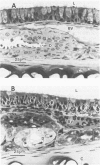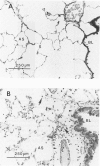Abstract
Certain inhaled toxicants are known to induce mucous hypersecretion in the respiratory epithelium. This secretory change may be a direct effect of the toxicant or an indirect effect of the concomitant inflammatory response. The present study was designed to determine by quantitative histochemistry whether the influx of neutrophils through the nasal respiratory epithelium would induce significant quantitative changes in the amount of intraepithelially stored mucosubstance. F344/N rats were intranasally instilled with endotoxin to elicit a transient influx of neutrophils into the nasal epithelium. Peak intraepithelial infiltration of neutrophils was evident 6 hours after instillation. There was a concurrent quantitative decrease in stored epithelial mucosubstance at the same time after instillation. Amounts of epithelial mucosubstance returned to that measured prior to neutrophil infiltration by 24 hours after instillation, when intraepithelial neutrophils were diminishing. Rats in which circulating neutrophils were sequestered in the lungs and prevented from migrating into endotoxin-exposed nasal epithelium had no change in the quantity of stored mucosubstance 6 hours after instillation. Therefore, it is concluded that a transepithelial migration of neutrophils elicits a transient depletion of stored mucosubstances in the nasal respiratory epithelium. Whether this is due to the release of secretagogues from the migrating leukocytes or another neutrophil-related method of stimulating mucous secretion is not known.
Full text
PDF










Images in this article
Selected References
These references are in PubMed. This may not be the complete list of references from this article.
- Adler K. B., Brody A. R., Craighead J. E. Studies on the mechanism of mucin secretion by cells of the porcine tracheal epithelium. Proc Soc Exp Biol Med. 1981 Jan;166(1):96–106. doi: 10.3181/00379727-166-41030. [DOI] [PubMed] [Google Scholar]
- Adler K. B., Hendley D. D., Davis G. S. Bacteria associated with obstructive pulmonary disease elaborate extracellular products that stimulate mucin secretion by explants of guinea pig airways. Am J Pathol. 1986 Dec;125(3):501–514. [PMC free article] [PubMed] [Google Scholar]
- Boat T. F., Kleinerman J. I. Human respiratory tract secretions. 2. Effect of cholinergic and adrenergic agents on in vitro release of protein and mucous glycoprotein. Chest. 1975 Feb;67(2 Suppl):32S–34S. doi: 10.1378/chest.67.2_supplement.32s. [DOI] [PubMed] [Google Scholar]
- Bowden D. H. Cell turnover in the lung. Am Rev Respir Dis. 1983 Aug;128(2 Pt 2):S46–S48. doi: 10.1164/arrd.1983.128.2P2.S46. [DOI] [PubMed] [Google Scholar]
- Clark J. N., Dalbey W. E., Stephenson K. B. Effect of sulfur dioxide on the morphology and mucin biosynthesis by the rat trachea. J Environ Pathol Toxicol. 1980 Nov;4(5-6):197–207. [PubMed] [Google Scholar]
- Coles S. J., Levine L. R., Reid L. Hypersecretion of mucus glycoproteins in rat airways induced by tobacco smoke. Am J Pathol. 1979 Mar;94(3):459–472. [PMC free article] [PubMed] [Google Scholar]
- De Haller R., Reid L. Adult chronic bronchitis. Morphology, histochemistry and vascularisation of the bronchial mucous glands. Med Thorac. 1965;22(6):549–567. [PubMed] [Google Scholar]
- De Water R., Willems L. N., Van Muijen G. N., Franken C., Fransen J. A., Dijkman J. H., Kramps J. A. Ultrastructural localization of bronchial antileukoprotease in central and peripheral human airways by a gold-labeling technique using monoclonal antibodies. Am Rev Respir Dis. 1986 May;133(5):882–890. [PubMed] [Google Scholar]
- Harkema J. R., Plopper C. G., Hyde D. M., St George J. A. Regional differences in quantities of histochemically detectable mucosubstances in nasal, paranasal, and nasopharyngeal epithelium of the bonnet monkey. J Histochem Cytochem. 1987 Mar;35(3):279–286. doi: 10.1177/35.3.2434556. [DOI] [PubMed] [Google Scholar]
- Hochstrasser K., Albrecht G. J., Schönberger O. L., Rasche B., Lempart K. An elastase-specific inhibitor from human bronchial mucus. Isolation and characterization. Hoppe Seylers Z Physiol Chem. 1981 Oct;362(10):1369–1375. doi: 10.1515/bchm2.1981.362.2.1369. [DOI] [PubMed] [Google Scholar]
- Hudson A. R., Kilburn K. H., Halprin G. M., McKenzie W. N. Granulocyte recruitment to airways exposed to endotoxin aerosols. Am Rev Respir Dis. 1977 Jan;115(1):89–95. doi: 10.1164/arrd.1977.115.1.89. [DOI] [PubMed] [Google Scholar]
- Johnson H. G., Chinn R. A., Morton D. R., McNee M. L., Miller M. D., Nadel J. A. Diphenhydramine blocks the leukotriene-C4 enhanced mucus secretion in canine trachea in vivo. Agents Actions. 1983 Feb;13(1):1–4. doi: 10.1007/BF01994273. [DOI] [PubMed] [Google Scholar]
- Kueppers F., Bromke B. J. Protease inhibitors in tracheobronchial secretions. J Lab Clin Med. 1983 May;101(5):747–757. [PubMed] [Google Scholar]
- LEV R., SPICER S. S. A HISTOCHEMICAL COMPARISON OF HUMAN EPITHELIAL MUCINS IN NORMAL AND IN HYPERSECRETORY STATES INCLUDING PANCREATIC CYSTIC FIBROSIS. Am J Pathol. 1965 Jan;46:23–47. [PMC free article] [PubMed] [Google Scholar]
- Lamb D., Reid L. The tracheobronchial submucosal glands in cystic fibrosis: a qualitative and quantitative histochemical study. Br J Dis Chest. 1972 Oct;66(4):239–247. doi: 10.1016/0007-0971(72)90042-3. [DOI] [PubMed] [Google Scholar]
- Last J. A., Jennings M. D., Schwartz L. W., Cross C. E. Glycoprotein secretion by tracheal explants cultured from rats exposed to ozone. Am Rev Respir Dis. 1977 Oct;116(4):695–703. doi: 10.1164/arrd.1977.116.4.695. [DOI] [PubMed] [Google Scholar]
- Marom Z., Shelhamer J. H., Bach M. K., Morton D. R., Kaliner M. Slow-reacting substances, leukotrienes C4 and D4, increase the release of mucus from human airways in vitro. Am Rev Respir Dis. 1982 Sep;126(3):449–451. doi: 10.1164/arrd.1982.126.3.449. [DOI] [PubMed] [Google Scholar]
- McDowell E. M., Combs J. W., Newkirk C. Changes in secretory cells of hamster tracheal epithelium in response to acute sublethal injury: a quantitative study. Exp Lung Res. 1983 Apr;4(3):227–243. doi: 10.3109/01902148309046062. [DOI] [PubMed] [Google Scholar]
- Neutra M., Leblond C. P. Synthesis of the carbohydrate of mucus in the golgi complex as shown by electron microscope radioautography of goblet cells from rats injected with glucose-H3. J Cell Biol. 1966 Jul;30(1):119–136. doi: 10.1083/jcb.30.1.119. [DOI] [PMC free article] [PubMed] [Google Scholar]
- Niles R. M., Christensen T. G., Breuer R., Stone P. J., Snider G. L. Serine proteases stimulate mucous glycoprotein release from hamster tracheal ring organ culture. J Lab Clin Med. 1986 Nov;108(5):489–497. [PubMed] [Google Scholar]
- Phipps R. J., Nadel J. A., Davis B. Effect of alpha-adrenergic stimulation on mucus secretion and on ion transport in cat trachea in vitro. Am Rev Respir Dis. 1980 Feb;121(2):359–365. doi: 10.1164/arrd.1980.121.2.359. [DOI] [PubMed] [Google Scholar]
- Reynolds H. Y., Merrill W. W. Airway changes in young smokers that may antedate chronic obstructive lung disease. Med Clin North Am. 1981 May;65(3):667–689. doi: 10.1016/s0025-7125(16)31518-8. [DOI] [PubMed] [Google Scholar]
- Snider G. L., Lucey E. C., Christensen T. G., Stone P. J., Calore J. D., Catanese A., Franzblau C. Emphysema and bronchial secretory cell metaplasia induced in hamsters by human neutrophil products. Am Rev Respir Dis. 1984 Jan;129(1):155–160. doi: 10.1164/arrd.1984.129.1.155. [DOI] [PubMed] [Google Scholar]
- Sturgess J., Reid L. An organ culture study of the effect of drugs on the secretory activity of the human bronchial submucosal gland. Clin Sci. 1972 Oct;43(4):533–543. doi: 10.1042/cs0430533. [DOI] [PubMed] [Google Scholar]
- Young J. T. Histopathologic examination of the rat nasal cavity. Fundam Appl Toxicol. 1981 Jul-Aug;1(4):309–312. doi: 10.1016/s0272-0590(81)80037-1. [DOI] [PubMed] [Google Scholar]





